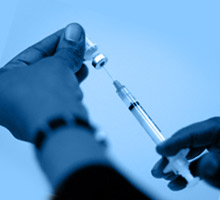 |
Cervical cancer has been studied to have an infectious origin. A certain virus, namely, Human Papilloma Virus (HPV) has been isolated from cytological (cellular) specimens collected from the cervix of cervical cancer patients. |
Undoubtedly, vaccination is the most convenient method to prevent diseases. The good news is that we now have this most sought after preventive measure for cancer. Although not all cancers can be prevented by vaccines, cervical cancer has emerged as one of the first cancers that can be prevented by vaccination. Cervical cancer has been studied to have an infectious origin. A certain virus, namely, Human Papilloma Virus (HPV) has been isolated from cytological (cellular) specimens collected from the cervix of cervical cancer patients. This gives a strong relationship between cancer of the cervix and HPV, which plays a vital role in triggering a mutation that causes the cancer.
Human papilloma virus has also been linked to other parts of female genital tract, male genital tract and also the oral cavity, pharynx and larynx. However, cervical cancer seems to have a strong relationship with HPV, as it was isolated from almost all the studied cases of cervical cancer. Human Papilloma Virus is a DNA virus, and its major types operating in cancer are HPV types 6, 11, 16 and 18. Studies reveal that HPV 16 and 18 are more aggressive, and responsible for approximately 70% of cervical cancers worldwide, and about 50% of pre-cancerous lesions. HPV 6 and 11 are somewhat milder, and mostly implicated in causing genital warts, which is a non malignant condition frequently seen in young promiscuous individuals.
With the help of recent research, two vaccines have been formulated. One of them targets four HPV types - 6, 11, 16 and 18. The other vaccine mainly acts against HPV types 16 and 18. These vaccines have been tested and have been approved by the Food and Drug Administration (FDA) of United States and also by the European Medicines Agency (EMEA).
The tetravalent vaccine (vaccine against 4 types of HPV; 6, 11, 16, 18) may be used to give protection against both the pre-cancerous, cancerous and also the non-cancerous or nonmalignant infections caused by HPV. However, bivalent vaccines (vaccine against two types of HPV - 16, 18) are known to provide protection against cancer of the cervix, pre-cancerous lesion of the vagina or vulva. By pre-cancerous, we mean to say that this lesion by itself is not malignant but may proceed or inherently become cancerous or malignant with a potential to spread to the surrounding area and onwards.
|
Limitations of HPV vaccines
- There is no sufficient data to predict the long term protection of these vaccines. The long-term efficacy and protection rendered against cancer by these vaccines is still under surveillance in large phase studies, consisting of thousands of individuals.
- These vaccines provide protection against cervical cancer in HPV negative individuals. In other words, these vaccines are of little help in already diagnosed cases of cervical cancer, as they will not play any role in modifying an established disease process.
- Young women who have already been exposed to HPV, due to sexual promiscuity or contact, and those who may not show any symptoms of the disease, or in other words, are asymptomatic carriers of the virus in their body, may have little or no protection by these vaccines.
- These bivalent and tetravalent HPV vaccines may have little role against other types of HPV causing cancers, i.e., other high risk HPV types (26, 53 and 66) and low risk HPV types (40, 42, 43, 44, 54, 61, 70, 72, 81 and CP6108.) [2]
- Another line that limits the incorporation of HPV vaccines into the present era is the cost of these vaccines, which exceeds the affordability of many countries, especially the developing countries that make the majority of cervical cancers detected worldwide.
|
In summary, cervical cancer screening programs still remain the mainstay of prevention against this deadly yet soon to become a vaccine preventable disease. |
|